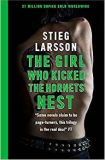The Girl Who Kicked The Hornets' Nest by Stieg Larsson and Reg Keeland (translator)
| The Girl Who Kicked The Hornets' Nest by Stieg Larsson and Reg Keeland (translator) | |
|
| |
| Category: Crime | |
| Reviewer: Paul Curd | |
| Summary: In the final volume of Larsson's Millennium trilogy, quirky anti-hero Lisbeth Salander battles for justice against dark forces within the Swedish secret service. Less action-packed than the previous volumes, The Girl Who Kicked the Hornets' Nest nevertheless delivers a complex, well-plotted story that's a cut above the usual conspiracy thriller. | |
| Buy? Yes | Borrow? Yes |
| Pages: 602 | Date: October 2009 |
| Publisher: Maclehose Press | |
| ISBN: 978-1906694166 | |
|
| |
The Girl with the Dragon Tattoo, the first of Steig Larsson's Millennium trilogy of thrillers, was a fine stand-alone novel. The second in the series, The Girl Who Played With Fire, continues the adventures of Lisbeth Salander, Larsson's finely crafted anti-hero. If you haven't read this second volume yet I advise you to stop reading this review now. I'm about to spoil the ending for you…
The Girl Who Played With Fire finishes with a cliffhanger – Salander has been shot three times and has a bullet lodged in her brain. She is barely alive when Larsson's alter-ego, Mikael Blomkvist, finds her mangled body. The book ends with him dialling the number for emergency services.
The Girl Who Kicked the Hornets' Nest begins a few hours later. Salander has been rushed to hospital in a helicopter, together with her father, the Russian gangster and former spy Alexander Zalachenko. Salander, you may remember, planted an axe in her father's head shortly after he had planted the bullet in hers. Meanwhile, Salander's giant of a half-brother, Ronald Niedermann, has managed to escape and go on the run.
The first half of the book is concerned with Salander's recovery. She is isolated in a hospital room and knows her father (who still wants to kill her) is in a room just along the corridor – although that changes in dramatic fashion. There is, though, a paucity of dramatic incident in the first part of this third episode. Much of the narrative is taken up with meetings or conferences or phone calls in which the various (and growing number of) characters discuss how we got where we are. It becomes clear that events from Salander's traumatic past – her diagnosis as mentally ill, the abuse she suffered at the hands of her state-appointed guardian – have been orchestrated by dark forces at the very heart of Swedish society.
Of course, there is more to the book than just that. The Girl Who Kicked the Hornets' Nest is a mesh of intricate plots and sub-plots that examine Swedish society, its government and police, right-wing extremists, the newspaper business and Blomkvist's love life. At one stage, on page 281, one of the characters sighs to himself that the story was beginning to get tremendously complicated. But Larsson holds the plot together with considerable expertise (although he does have a habit of reminding the reader where we are every time a new player is introduced through the device of having someone explain to the newly-introduced character the story so far – some readers may find that helpful, this reviewer found it increasingly annoying).
There are other areas that were somewhat irritating. For me there was far too much exposition – sometimes pages and pages of it in the early part of the book – and not nearly as much action as in the earlier volumes of the trilogy. I felt the pace of Larsson's story would have benefited from the blue pencil of a good editor, and some of the characterisations (Salander apart) are so flat it's impossible for them to rise from the page. But the themes – violence by men against women, the corruption that results from power, the misuse of psychiatry, the importance of a free press – are powerful, and Larsson gets his points across cleverly within the context of the story, often through the mouths of his villains, leaving the reader to draw their own conclusions. Larsson was, after all, a consummate storyteller.
Although the ending provides a satisfying rounding-off of the Millennium trilogy, there are one or two minor loose ends that will never be tied up. It's rumoured that Larsson planned another seven volumes in this series. His untimely death has robbed us of those. We are left to savour what we have.
I'd like to thank the publishers for sending a copy to The Bookbag.
The Girl with the Dragon Tattoo and (especially) The Girl who Played with Fire are essential to full enjoyment of this final volume in the trilogy. For more Swedish crime, then anything by Henning Mankell is sure to satisfy. If it's a quirky female protagonist you're after they don't come much quirkier than Ariel Manto in Scarlett Thomas's The End of Mr Y. We can also recommend Poppet by Mo Hayder.
The Lisbeth Salander ''Millennium'' Books in Chronological Order
Please share on: ![]() Facebook,
Facebook, ![]() Twitter and
Twitter and
![]() Instagram
Instagram
![]() You can read more book reviews or buy The Girl Who Kicked The Hornets' Nest by Stieg Larsson and Reg Keeland (translator) at Amazon.co.uk Amazon currently charges £2.99 for standard delivery for orders under £20, over which delivery is free.
You can read more book reviews or buy The Girl Who Kicked The Hornets' Nest by Stieg Larsson and Reg Keeland (translator) at Amazon.co.uk Amazon currently charges £2.99 for standard delivery for orders under £20, over which delivery is free.
![]() You can read more book reviews or buy The Girl Who Kicked The Hornets' Nest by Stieg Larsson and Reg Keeland (translator) at Amazon.com.
You can read more book reviews or buy The Girl Who Kicked The Hornets' Nest by Stieg Larsson and Reg Keeland (translator) at Amazon.com.
Comments
Like to comment on this review?
Just send us an email and we'll put the best up on the site.


